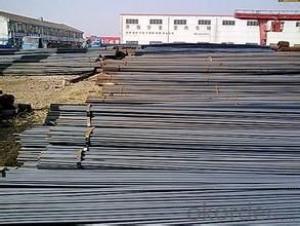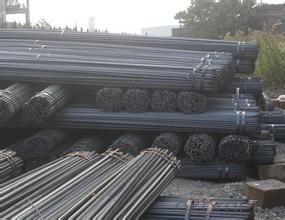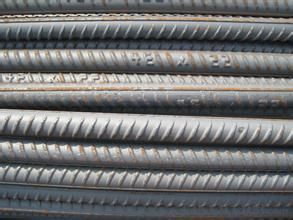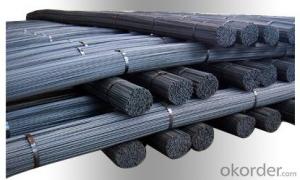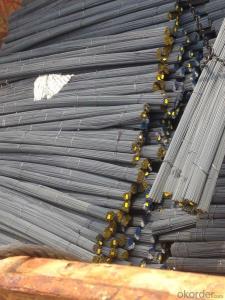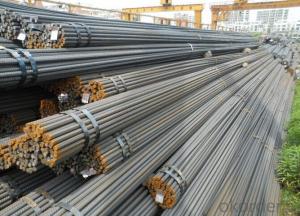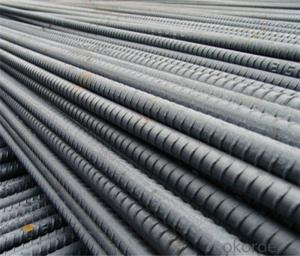GB1449 deformed steel bar for construction
- Loading Port:
- Tianjin
- Payment Terms:
- TT OR LC
- Min Order Qty:
- 25 m.t.
- Supply Capability:
- 10000 m.t./month
OKorder Service Pledge
OKorder Financial Service
You Might Also Like
Product Description:
Specifications of Deformed Steel Bar:
Standard | GB | HRB335, HRB400, HRB500 | |
UK | G460B, B500A, B500B,B500C | ||
USA | GR40, GR60 | ||
Diameter | 6mm,8mm,10mm,12mm,14mm,16mm,18mm,20mm, 22mm,25mm,28mm,32mm,36mm,40mm,50mm | ||
Length | 6M, 9M,12M or as required | ||
Place of origin | Hebei, China mainland | ||
Application | building,construction,road,bridge etc | ||
Brand name | DRAGON | ||
Theoretical weight and section area of each diameter as below for your information:
Diameter(mm) | Section area (mm²) | Mass(kg/m) |
6 | 28.27 | 0.222 |
8 | 50.27 | 0.395 |
10 | 78.54 | 0.617 |
12 | 113.1 | 0.888 |
14 | 153.9 | 1.21 |
16 | 201.1 | 1.58 |
18 | 254.5 | 2.00 |
20 | 314.2 | 2.47 |
22 | 380.1 | 2.98 |
25 | 490.9 | 3.85 |
28 | 615.8 | 4.83 |
32 | 804.2 | 6.31 |
36 | 1018 | 7.99 |
40 | 1257 | 9.87 |
50 | 1964 | 15.42 |
Usage and Applications of Deformed Steel Bar:
Deformed bar is widely used in buildings, bridges, roads and other engineering construction. Big to highways, railways, bridges, culverts, tunnels, public facilities such as flood control, dam, small to housing construction, beam, column, wall and the foundation of the plate, deformed bar is an integral structure material. With the development of world economy and the vigorous development of infrastructure construction, real estate, the demand for deformed bar will be larger and larger..
Packaging & Delivery of Deformed Steel Bar:
Packaging Detail: products are packed in bundle and then shipped by container or bulk vessel, deformed bar is usually naked strapping delivery, when storing, please pay attention to moisture proof. The performance of rust will produce adverse effect.
Each bundle weight: 2-3MT, or as required
Payment term: TT or L/C
Delivery Detail: within 45 days after received advanced payment or LC.
Label: to be specified by customer, generally, each bundle has 1-2 labels
Trade terms: FOB, CFR, CIF
Deformed Steel Bar in Coil
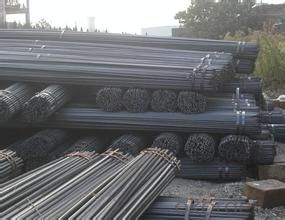
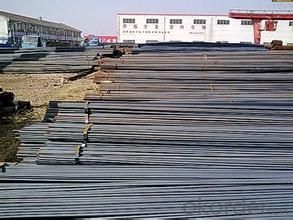
Produce Line of Deformed Steel Bar
Note:
1. Our products are produced according to national standard (GB), if not, supply according to national standards (GB) or agreement as customer required.
2. Other Grade and Standard Deformed Steel Bar we can supply:
Grade: GR40/GR60, G460B/B500A/B500B/B500C,BST500S
Standard: ASTM, BS, DIN
The Minimum Order Quantity of these products is high, and need to be confirmed.
3. We can not only supply Deformed Steel Bar; if you need anything about building materials, please contact us for further information.
4. Please send us your detail specifications when inquire. We will reply to you as soon as possible. We sincerely hope we can establish a long stable business relationship.
- Q: What is the process of epoxy-coating steel rebars?
- To achieve a durable and corrosion-resistant coating on steel rebars, several steps are involved in the process of epoxy-coating. Here is a general overview of the process: Firstly, the steel rebars undergo thorough surface preparation to eliminate any rust, oil, or other contaminants. This can be accomplished through techniques such as sandblasting or chemical cleaning. Once the rebars are cleaned, a primer is applied to enhance adhesion between the steel surface and the epoxy coating. Additionally, the primer provides an extra layer of protection against corrosion. After the primer has dried, the epoxy coating is applied to the rebars. This can be done using various methods, including spray application or immersing the rebars in an epoxy tank. Following the application of the epoxy coating, the rebars are left to cure. This controlled process allows the coating to harden and fully bond with the steel surface. The curing time varies depending on the specific epoxy and environmental conditions. Once the rebars have cured, a thorough inspection is conducted to ensure the uniform application of the epoxy coating and that it meets the required specifications. This inspection may involve visual checks, adhesion tests, and measurements of coating thickness. After passing inspection, the epoxy-coated steel rebars are packaged and stored in a controlled environment to protect them from damage or further contamination. It is important to note that the specific process may vary depending on factors such as the manufacturer, project requirements, and the type of epoxy coating used. Following industry standards and guidelines is crucial to ensure the quality and effectiveness of the epoxy-coated steel rebars.
- Q: Cold drawn steel wire is a round bar or thread steel in Construction Engineering
- Of course it belongs to round bar. Thread steel can not be obtained by cold drawing. Besides, the outer diameter of the cold drawn steel wire is smaller, the surface is smoother and the hardness is slightly higher.
- Q: Are there any environmental concerns associated with steel rebars?
- Steel rebars have various environmental concerns associated with them. One of the main worries is the production process, which involves extracting and processing iron ore. This process is energy-intensive and can contribute to greenhouse gas emissions and air pollution. Moreover, mining for iron ore can cause habitat destruction and displace wildlife. Another environmental concern is the potential corrosion of steel rebars over time, especially in marine and coastal environments. Corrosion can result in structural degradation, leading to the need for replacement and increased resource and energy consumption. Furthermore, the disposal of steel rebars at the end of their lifespan can also create environmental challenges. If not managed properly, steel rebars may end up in landfills, occupying valuable space and potentially releasing harmful substances into the environment. Nevertheless, it is important to highlight that steel rebars are often recycled, which helps alleviate some of these environmental concerns. Recycling steel rebars reduces the demand for new production, conserves natural resources, and decreases energy consumption and greenhouse gas emissions. Additionally, the use of recycled steel rebars helps prevent the disposal of these materials in landfills. In conclusion, while steel rebars have environmental concerns, proper management and recycling practices can minimize their impact on the environment.
- Q: What's the difference between round bar and screw steel? Which one is cheaper on the market at present?
- Steel is known as hot rolled ribbed bar. The specification of rebar is large, and it belongs to small section steel. It is mainly used for the skeleton of reinforced concrete construction component. Generally required in the use of a certain mechanical strength, bending deformation properties and welding process performance.
- Q: What is the difference between carbon steel and stainless steel rebars?
- Both carbon steel and stainless steel rebars are utilized in construction as types of steel reinforcement. However, they differ significantly in their composition and properties. Carbon steel rebars consist of a combination of iron and carbon, with trace amounts of other elements like manganese and copper. The carbon content in these rebars typically ranges from 0.15% to 0.60%. They possess strength, durability, and cost-effectiveness. Their tensile strength is crucial for reinforcing concrete structures. Nevertheless, they are prone to corrosion if not adequately protected, especially in environments with high moisture or exposure to chemicals. On the contrary, stainless steel rebars are created by combining iron, chromium, nickel, and other alloying elements. The chromium content in stainless steel usually exceeds 10.5%, leading to the formation of a protective layer of chromium oxide on the rebar's surface, which prevents corrosion. Stainless steel rebars exhibit exceptional corrosion resistance, even in harsh environments with high humidity, saltwater, or exposure to chemicals. Additionally, they are highly durable and possess high tensile strength, similar to carbon steel rebars. The primary distinction between carbon steel and stainless steel rebars lies in their corrosion resistance. Carbon steel rebars necessitate the application of protective coatings like epoxy or galvanization to prevent corrosion. In contrast, stainless steel rebars possess inherent corrosion resistance due to the presence of the chromium oxide layer, eliminating the need for additional coatings. Another differing factor is the cost. Carbon steel rebars are generally more affordable compared to stainless steel rebars. However, the total project cost should also consider the long-term maintenance expenses associated with corrosion protection measures required for carbon steel rebars. To summarize, carbon steel rebars are strong and cost-effective but require supplementary corrosion protection, while stainless steel rebars exhibit excellent corrosion resistance and durability at a higher cost. The selection between the two depends on the specific project requirements, budget constraints, and anticipated environmental conditions.
- Q: What is the difference between the actual weight and the actual weight of the steel thread?
- The actual weight is weighed and weight is calculated according to the theory of diameter *0.00617*M* diameter * * the number of root number general weight were weighed weight greater than you look at this with the giant is even large or small factory of some difference.
- Q: What is hot rolled coil? Hot rolled coil relative to thread steel and other steel, is not considered a higher point?
- The thread steel is a long piece of steel pulled out at a certain temperature.There is no high or no advanced problem between the two.
- Q: What is the impact of steel rebars on the constructability of a project?
- The constructability of a project is greatly affected by steel rebars, which play a vital role in reinforcing and providing structural integrity to concrete structures. By incorporating steel rebars, the overall strength, durability, and resilience of a construction project are significantly improved. One important impact of using steel rebars is the increased load-bearing capacity of the structure. Rebars are designed to withstand tension, complementing the concrete's ability to resist compression. This combination enhances the structural strength of the project, enabling it to withstand heavy loads and external forces, such as earthquakes or high winds. Moreover, steel rebars also enhance the ductility of the concrete structure. Ductility refers to the material's ability to deform without breaking. By adding rebars, the concrete becomes more flexible, allowing it to absorb energy and deform under stress before reaching its breaking point. This is particularly important in areas prone to seismic activities, as it helps prevent sudden and catastrophic failure of the structure. Another aspect of constructability affected by steel rebars is the overall lifespan of the project. The corrosion resistance properties of rebars, especially when coated or galvanized, significantly extend the lifespan of the structure. This is particularly relevant in environments with high humidity, coastal areas, or regions with harsh weather conditions. By preventing corrosion and maintaining the integrity of the rebars, the entire project's longevity and durability are greatly enhanced. Additionally, steel rebars also facilitate the construction process itself. Their availability in various lengths, shapes, and sizes allows for flexible and efficient design and construction. Contractors can easily cut, bend, and shape rebars to fit specific project requirements, reducing construction time and costs. Moreover, rebars can be prefabricated off-site, minimizing on-site labor and simplifying the construction process. In conclusion, the impact of steel rebars on the constructability of a project is highly significant. They improve the overall strength, load-bearing capacity, ductility, and lifespan of the structure. Additionally, the flexibility and ease of use of steel rebars contribute to efficient construction practices. Therefore, incorporating steel rebars into a project is essential for ensuring its structural integrity and long-term success.
- Q: What are the common mistakes to avoid when installing steel rebars?
- To ensure a successful and safe installation of steel rebars, it is important to avoid several common mistakes: 1. Placing the rebars incorrectly is a frequent error that must be avoided. Accurate placement should be carried out in accordance with the engineering or construction drawings. Any deviation from the specified location can compromise the structural integrity of the reinforced concrete. 2. Insufficient concrete cover over the rebars is another mistake to avoid. The cover acts as a protective layer, preventing corrosion and providing fire resistance. Inadequate cover can lead to premature deterioration and structural failure over time. 3. Proper support for the rebars is crucial during the concrete pouring process. Insufficient support can cause sagging or movement of the rebars, resulting in an uneven distribution of steel reinforcement and compromising the structural strength of the concrete. 4. Correct alignment and spacing of the rebars according to design specifications is essential. Improper alignment can lead to congestion, difficulties in pouring concrete, and compromised bond strength between the rebar and concrete. Similarly, incorrect spacing can result in insufficient reinforcement, reducing the overall strength of the structure. 5. Thoroughly cleaning the rebars before installation is necessary to remove rust, dirt, and other contaminants. Failure to do so can lead to poor bond strength and an increased risk of corrosion, weakening the structure over time. 6. Adequate tying of the rebars using the appropriate wire or connectors is essential to maintain alignment and ensure the structural integrity of the reinforced concrete. Neglecting proper tying can result in shifting or movement during the concrete pouring process, compromising the structural strength. 7. Lack of supervision and quality control during the installation process is a common mistake. Experienced personnel should oversee the installation to ensure compliance with design specifications, proper installation techniques, and adherence to safety guidelines. By avoiding these common mistakes, the installation of steel rebars can be carried out effectively, resulting in a strong, durable, and safe reinforced concrete structure.
- Q: What is the role of steel rebars in the construction of railway bridges?
- The role of steel rebars in the construction of railway bridges is to provide reinforcement and strength to the concrete structure. Rebars are embedded within the concrete to enhance its tensile strength, allowing the bridge to withstand heavy loads, vibrations, and environmental factors such as temperature changes. This reinforcement ensures the structural integrity and longevity of the railway bridge, making it safe and durable for train traffic.
Send your message to us
GB1449 deformed steel bar for construction
- Loading Port:
- Tianjin
- Payment Terms:
- TT OR LC
- Min Order Qty:
- 25 m.t.
- Supply Capability:
- 10000 m.t./month
OKorder Service Pledge
OKorder Financial Service
Similar products
Hot products
Hot Searches
Related keywords
